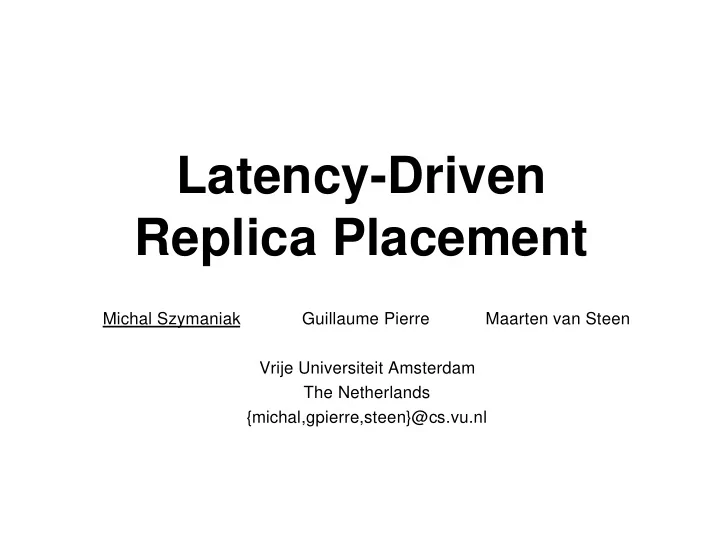

Latency-Driven Replica Placement Michal Szymaniak Guillaume Pierre Maarten van Steen Vrije Universiteit Amsterdam The Netherlands {michal,gpierre,steen}@cs.vu.nl
Problem Description • Large distributed system – Thousands+ of nodes • Wide-area network – Internet • Node = client + server – Nodes can host content • Most popular content is replicated – Thousands of possible replica locations • Where to place replicas efficiently? • Efficient = minimal average client-to-replica latency • Clients always use their closest replicas 2
Current Solutions • Greedy – Place replicas one-by-one – Each time evaluate all possible locations – Good placement quality – O(K*N^2), K replicas, N candidate locations • Hot-Spot – Compute load generated by each location – Place replicas in K most active locations – Slightly worse quality than Greedy – O(N^2+min(N*logN,K*N)) • Note: – O(N^2) is too much for large-scale systems – O(N^2) caused by all-pair latency calculations; can we get rid of them? 3
Our Two-Step Solution • 1: Cluster locations; choose clusters for replicas – Clustered nodes close in terms of latency • 2: Select nodes inside clusters – Current work • Identify clusters efficiently (HotZone) – Model latencies such that clustering is cheap – We use Global Network Positioning (GNP) • HotZone identifies clusters in O(N*max(logN,K)) 4
Agenda • Efficient Latency Modeling – Global Network Positioning • Cluster Identification • Performance – Placement Quality – Computation Times • Conclusion 5
Efficient Latency Modeling • Global Network Positioning (GNP): – Internet == M-dimensional geometric space – Nodes == M-dimensional positions – Latencies == distances between positions • GNP can be run efficiently even in large-scale systems – Previous work • So: we play with points in geometric space • How to identify clusters of points? 6
Cluster Identification • Divide space into M-dimensional hypercubes (cells) • Cell density = number of nodes inside cell • We are done! Take most dense cells as clusters! • Not quite: – We could cut clusters into pieces.. – ..which can be too small.. – ..to be assigned replicas :-( • What can we do about it? 7
Fixing Split Clusters • Solution: adjust density definition – Cell density = the number of nodes INSIDE + AROUND the cell. – After placing each replica - remove nodes that replica shall service! • What if we cannot unambiguously identify dense cells? – Wrong cell size; adjust it to node distribution. 8
Performance • Placement Quality.. ..and Computation Time • Tested for 64k nodes (clients == possible replica locations) 9
Conclusions and Future Work • Two-step replica placement for large-scale systems: – 1. Cluster locations according to latency; choose biggest clusters – 2. Inspect chosen clusters to select nodes that will hold replicas • First step - HotZone: – Relies on geometric system model provided by GNP – Identifies biggest node clusters at low cost: O(N*max(logN,K)) – Preserves ultimate placement quality • Second step - Current work: – Not so many nodes -- consider their individual properties – Clusters = virtual servers; they will dynamically manage local replicas 10
Thank you! Questions? 11
Extras: Complexity • Entry: we know positions of all N nodes • Divide geometric space into O(N) cells: O(N) – For each position: O(1) to identify target cell – Cells identified by their center positions • Calculate densities O(NlogN) – O(N) to calculate all cell densities – O(N) merges with neighbor densities – But: neighbor lookup costs O(logN) in our data structures • Choose K clusters for replicas O(KN) – For each replica: O(N) to find most dense cell.. – ..and O(logN) to remove that cell and its neighbors • Total: O(N*max(logN,K)) 12
Extras: Cell Size • Cell size C intuitively depends on two factors: – node distribution (e.g., average inter-node distance D) – number of replicas to place K • Let C=A*D/K^B; (A,B) - parameters • Obtain (A,B) using non-linear regression: – Try all (C,D,K) combinations on a sample – Identify best C values for all (D,K) pairs – Assign (A,B) such that best C~= A*D/K^B • Experiments: – A~1/8, B~1/3 for our sample – (A,B) will vary for other datsets – Still: placement quality resilient to small changes in A and B 13
14
Recommend
More recommend